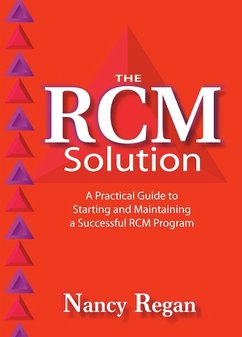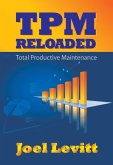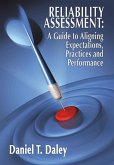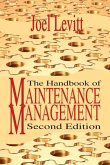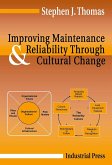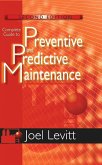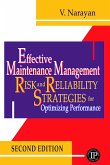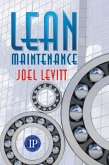Nancy Regan
The RCM Solution (eBook, ePUB)
A Practical Guide to Starting and Maintaining a Successful RCM Program
44,95 €
44,95 €
inkl. MwSt.
Sofort per Download lieferbar

22 °P sammeln
44,95 €
Als Download kaufen

44,95 €
inkl. MwSt.
Sofort per Download lieferbar

22 °P sammeln
Jetzt verschenken
Alle Infos zum eBook verschenken
44,95 €
inkl. MwSt.
Sofort per Download lieferbar
Alle Infos zum eBook verschenken

22 °P sammeln
Nancy Regan
The RCM Solution (eBook, ePUB)
A Practical Guide to Starting and Maintaining a Successful RCM Program
- Format: ePub
- Merkliste
- Auf die Merkliste
- Bewerten Bewerten
- Teilen
- Produkt teilen
- Produkterinnerung
- Produkterinnerung

Bitte loggen Sie sich zunächst in Ihr Kundenkonto ein oder registrieren Sie sich bei
bücher.de, um das eBook-Abo tolino select nutzen zu können.
Hier können Sie sich einloggen
Hier können Sie sich einloggen
Sie sind bereits eingeloggt. Klicken Sie auf 2. tolino select Abo, um fortzufahren.

Bitte loggen Sie sich zunächst in Ihr Kundenkonto ein oder registrieren Sie sich bei bücher.de, um das eBook-Abo tolino select nutzen zu können.
This book is a "how-to" generic approach with minimal theory by a well-known and very active participant in the leading maintenance organizations and conferences. The book offers a fundamental, common sense understanding of RCM. A significant portion is dedicated to SAE JA1011 compliant RCM. The book presents detailed processes that can be used when RCM is not applicable and presents a total solution for implementing RCM for any organization.
The primary market for this book is anyone responsible for Physical Asset Management within an organization, at any level of authority. The…mehr
- Geräte: eReader
- mit Kopierschutz
- eBook Hilfe
- Größe: 7.95MB
Andere Kunden interessierten sich auch für
![TPM Reloaded (eBook, ePUB) TPM Reloaded (eBook, ePUB)]() Joel LevittTPM Reloaded (eBook, ePUB)36,95 €
Joel LevittTPM Reloaded (eBook, ePUB)36,95 €![Reliability Assessment: A Guide to Aligning Expectations, Practices, and Performance (eBook, ePUB) Reliability Assessment: A Guide to Aligning Expectations, Practices, and Performance (eBook, ePUB)]() Daniel DaleyReliability Assessment: A Guide to Aligning Expectations, Practices, and Performance (eBook, ePUB)39,95 €
Daniel DaleyReliability Assessment: A Guide to Aligning Expectations, Practices, and Performance (eBook, ePUB)39,95 €![Handbook of Maintenance Management (eBook, ePUB) Handbook of Maintenance Management (eBook, ePUB)]() Joel LevittHandbook of Maintenance Management (eBook, ePUB)61,95 €
Joel LevittHandbook of Maintenance Management (eBook, ePUB)61,95 €![Improving Maintenance and Reliability Through Cultural Change (eBook, ePUB) Improving Maintenance and Reliability Through Cultural Change (eBook, ePUB)]() Stephen J. ThomasImproving Maintenance and Reliability Through Cultural Change (eBook, ePUB)41,95 €
Stephen J. ThomasImproving Maintenance and Reliability Through Cultural Change (eBook, ePUB)41,95 €![Complete Guide to Preventive and Predictive Maintenance (eBook, ePUB) Complete Guide to Preventive and Predictive Maintenance (eBook, ePUB)]() Joel LevittComplete Guide to Preventive and Predictive Maintenance (eBook, ePUB)48,95 €
Joel LevittComplete Guide to Preventive and Predictive Maintenance (eBook, ePUB)48,95 €![Effective Maintenance Management (eBook, ePUB) Effective Maintenance Management (eBook, ePUB)]() V. NarayanEffective Maintenance Management (eBook, ePUB)44,95 €
V. NarayanEffective Maintenance Management (eBook, ePUB)44,95 €![Lean Maintenance (eBook, ePUB) Lean Maintenance (eBook, ePUB)]() Joel LevittLean Maintenance (eBook, ePUB)41,95 €
Joel LevittLean Maintenance (eBook, ePUB)41,95 €-
-
-
This book is a "how-to" generic approach with minimal theory by a well-known and very active participant in the leading maintenance organizations and conferences. The book offers a fundamental, common sense understanding of RCM. A significant portion is dedicated to SAE JA1011 compliant RCM. The book presents detailed processes that can be used when RCM is not applicable and presents a total solution for implementing RCM for any organization.
The primary market for this book is anyone responsible for Physical Asset Management within an organization, at any level of authority. The material will be just as valuable to an organization's maintenance manager as it would to the organization's leader. The book's principles will be presented generically so they are equally applicable to any industry in the world that has assets to care for - military, manufacturing, mining, plastics, power generation, etc. There is also a secondary market for this book at colleges and universities teaching reliability engineering.
Dieser Download kann aus rechtlichen Gründen nur mit Rechnungsadresse in A, D ausgeliefert werden.
Produktdetails
- Produktdetails
- Verlag: Industrial Press, Inc.
- Seitenzahl: 272
- Erscheinungstermin: 15. März 2011
- Englisch
- ISBN-13: 9780831190583
- Artikelnr.: 49555224
- Verlag: Industrial Press, Inc.
- Seitenzahl: 272
- Erscheinungstermin: 15. März 2011
- Englisch
- ISBN-13: 9780831190583
- Artikelnr.: 49555224
- Herstellerkennzeichnung Die Herstellerinformationen sind derzeit nicht verfügbar.
Nancy Regan is the founder and President of management consulting firm The Force, Inc. She is a graduate of Embry-Riddle Aeronautical University and holds a BS in Aerospace Engineering. As a U.S. Navy civilian engineer for seven years, Nancy completed Naval Aviation Maintenance Officer School. She served as a T-45 aircraft structural engineer. Nancy then became a team leader for RCM at the Naval Air Warfare Center. She instituted the RCM program on Naval Aviation Common Support Equipment. In 2001, Nancy founded The Force. She has accumulated more than 15 years of hands-on experience facilitating reliability centered maintenance analysis, conducting RCM training and assisting her clients with implementation of RCM programs. Among her many projects, she facilitated the CH-47 Chinook Helicopter (the U.S. Army’s heavy lifter). Nancy holds U.S. and foreign patents for a parts marking process she developed using her RCM experience.
1. Introduction to Reliability Centered Maintenance
1.1 What is RCM?
1.2 Elements that Influence a System
1.3 The Essence of RCM: Managing the Consequences of Failure
1.4 What RCM Can Yield
1.5 The Evolution of RCM Principles
1.6 The Development of RCM Principles
1.7 Definition of RCM
1.8 Defining Performance in the Context of RCM
1.9 Introduction to the RCM Process
1.10 Failure Modes and Effects Analysis (FMEA) and Failure Modes,
Effects, and Criticality Analysis (FMECA)
Summary
2. A Facilitated Working Group Approach to RCM
2.1 The Team Approach to Accomplishing Objectives
2.2 Elements that Influence a System
2.3 Failure Management Strategies
2.4 Historical Data and the RCM Process
2.5 Effective Working Groups
2.6 Benefits of a Facilitated Working Group Approach
Summary
3. The RCM Operating Context
3.1 What Is an Operating Context?
3.2 When Should an Operating Context Be Drafted?
3.3 What is Included in an Operating Context?
3.4 The Operating Context as a Living Document
Summary
4. Functions
4.1 Why Write Functions?
4.2 Two Types of Functions
4.3 Classifying Functions as Evident or Hidden
4.4 Composing Evident and Hidden Functions
4.5 Information Worksheet
4.6 Primary Functions
4.7 Secondary Functions
4.8 General Equipment Features that Typically Warrant Secondary
Functions
4.9 Tips Regarding Functions
Summary
5. Functional Failures
5.1 What Is a Functional Failure?
5.2 Two Types of Functional Failures
5.3 Composing Functional Failures
Summary
6. Failure Modes
6.1 What Is a Failure Mode?
6.2 Failure Modes and the Information Worksheet
6.3 Composing Failure Modes
6.4 What Failure Modes Should Be Included in an RCM Analysis?
6.5 How Detailed Should Failure Modes Be Written?
6.6 Identifying Failure Modes for Each Functional Failure
6.7 Miscellaneous Notes regarding Failure Modes
Summary
7. Failure Effects
7.1 What Is a Failure Effect?
7.2 Failure Effects and the Information Worksheet
7.3 Composing Failure Effects
7.4 Writing Failure Effects for Protective Devices
Summary
8. Failure Consequences
8.1 What Is a Failure Consequence?
8.2 Introduction to the Decision Diagram
8.3 Classifying Failure Modes as Evident or Hidden
8.4 Identifying Failure Consequences
8.5 Safety Consequences
8.6 Environmental Consequences
8.7 Operational Consequences
8.8 Non-Operational Consequences
Summary
9. Proactive Maintenance and Intervals
9.1 Proactive Maintenance in the Context of RCM
9.2 Criteria for Assigning a Proactive Maintenance Task
9.3 Scheduled Restoration and Scheduled Replacement Tasks
9.4 On-Condition Tasks
9.5 Combination of Tasks
9.6 Synchronizing Initial Task Intervals
Summary
10. Default Strategies
10.1 Procedural Checks
10.2 Failure Finding Tasks
10.3 Synchronizing Initial Task Intervals
10.4 No Scheduled Maintenance
10.5 Other Default Strategies
10.6 Important Notes Regarding Default Strategies
Summary
11. Analysis Validation and Implementation
11.1 Frequently Asked Questions About the Validation Process
11.2 Implementing RCM Analysis Results
Summary
12. How to Initiate—and Successfully Sustain—an RCM Program
12.1 The Steps to Initiate an RCM Program
12.2 Sustaining an RCM Program
Summary
13. Frequently Asked Questions and Common Misconceptions about RCM
13.1 RCM FAQs
13.2 Common Misconceptions Regarding the RCM Process
14. RCM Is Only Part of the Solution
14.1 Two Fundamental Realities of Asset Management
14.2 The Application of Processes Less Robust than RCM
14.3 The RCM Solution
Summary
Appendices:
Steps to Initiate an RCM Program
Steps to Successfully Complete RCM Pilot Projects
1.1 What is RCM?
1.2 Elements that Influence a System
1.3 The Essence of RCM: Managing the Consequences of Failure
1.4 What RCM Can Yield
1.5 The Evolution of RCM Principles
1.6 The Development of RCM Principles
1.7 Definition of RCM
1.8 Defining Performance in the Context of RCM
1.9 Introduction to the RCM Process
1.10 Failure Modes and Effects Analysis (FMEA) and Failure Modes,
Effects, and Criticality Analysis (FMECA)
Summary
2. A Facilitated Working Group Approach to RCM
2.1 The Team Approach to Accomplishing Objectives
2.2 Elements that Influence a System
2.3 Failure Management Strategies
2.4 Historical Data and the RCM Process
2.5 Effective Working Groups
2.6 Benefits of a Facilitated Working Group Approach
Summary
3. The RCM Operating Context
3.1 What Is an Operating Context?
3.2 When Should an Operating Context Be Drafted?
3.3 What is Included in an Operating Context?
3.4 The Operating Context as a Living Document
Summary
4. Functions
4.1 Why Write Functions?
4.2 Two Types of Functions
4.3 Classifying Functions as Evident or Hidden
4.4 Composing Evident and Hidden Functions
4.5 Information Worksheet
4.6 Primary Functions
4.7 Secondary Functions
4.8 General Equipment Features that Typically Warrant Secondary
Functions
4.9 Tips Regarding Functions
Summary
5. Functional Failures
5.1 What Is a Functional Failure?
5.2 Two Types of Functional Failures
5.3 Composing Functional Failures
Summary
6. Failure Modes
6.1 What Is a Failure Mode?
6.2 Failure Modes and the Information Worksheet
6.3 Composing Failure Modes
6.4 What Failure Modes Should Be Included in an RCM Analysis?
6.5 How Detailed Should Failure Modes Be Written?
6.6 Identifying Failure Modes for Each Functional Failure
6.7 Miscellaneous Notes regarding Failure Modes
Summary
7. Failure Effects
7.1 What Is a Failure Effect?
7.2 Failure Effects and the Information Worksheet
7.3 Composing Failure Effects
7.4 Writing Failure Effects for Protective Devices
Summary
8. Failure Consequences
8.1 What Is a Failure Consequence?
8.2 Introduction to the Decision Diagram
8.3 Classifying Failure Modes as Evident or Hidden
8.4 Identifying Failure Consequences
8.5 Safety Consequences
8.6 Environmental Consequences
8.7 Operational Consequences
8.8 Non-Operational Consequences
Summary
9. Proactive Maintenance and Intervals
9.1 Proactive Maintenance in the Context of RCM
9.2 Criteria for Assigning a Proactive Maintenance Task
9.3 Scheduled Restoration and Scheduled Replacement Tasks
9.4 On-Condition Tasks
9.5 Combination of Tasks
9.6 Synchronizing Initial Task Intervals
Summary
10. Default Strategies
10.1 Procedural Checks
10.2 Failure Finding Tasks
10.3 Synchronizing Initial Task Intervals
10.4 No Scheduled Maintenance
10.5 Other Default Strategies
10.6 Important Notes Regarding Default Strategies
Summary
11. Analysis Validation and Implementation
11.1 Frequently Asked Questions About the Validation Process
11.2 Implementing RCM Analysis Results
Summary
12. How to Initiate—and Successfully Sustain—an RCM Program
12.1 The Steps to Initiate an RCM Program
12.2 Sustaining an RCM Program
Summary
13. Frequently Asked Questions and Common Misconceptions about RCM
13.1 RCM FAQs
13.2 Common Misconceptions Regarding the RCM Process
14. RCM Is Only Part of the Solution
14.1 Two Fundamental Realities of Asset Management
14.2 The Application of Processes Less Robust than RCM
14.3 The RCM Solution
Summary
Appendices:
Steps to Initiate an RCM Program
Steps to Successfully Complete RCM Pilot Projects
1. Introduction to Reliability Centered Maintenance
1.1 What is RCM?
1.2 Elements that Influence a System
1.3 The Essence of RCM: Managing the Consequences of Failure
1.4 What RCM Can Yield
1.5 The Evolution of RCM Principles
1.6 The Development of RCM Principles
1.7 Definition of RCM
1.8 Defining Performance in the Context of RCM
1.9 Introduction to the RCM Process
1.10 Failure Modes and Effects Analysis (FMEA) and Failure Modes,
Effects, and Criticality Analysis (FMECA)
Summary
2. A Facilitated Working Group Approach to RCM
2.1 The Team Approach to Accomplishing Objectives
2.2 Elements that Influence a System
2.3 Failure Management Strategies
2.4 Historical Data and the RCM Process
2.5 Effective Working Groups
2.6 Benefits of a Facilitated Working Group Approach
Summary
3. The RCM Operating Context
3.1 What Is an Operating Context?
3.2 When Should an Operating Context Be Drafted?
3.3 What is Included in an Operating Context?
3.4 The Operating Context as a Living Document
Summary
4. Functions
4.1 Why Write Functions?
4.2 Two Types of Functions
4.3 Classifying Functions as Evident or Hidden
4.4 Composing Evident and Hidden Functions
4.5 Information Worksheet
4.6 Primary Functions
4.7 Secondary Functions
4.8 General Equipment Features that Typically Warrant Secondary
Functions
4.9 Tips Regarding Functions
Summary
5. Functional Failures
5.1 What Is a Functional Failure?
5.2 Two Types of Functional Failures
5.3 Composing Functional Failures
Summary
6. Failure Modes
6.1 What Is a Failure Mode?
6.2 Failure Modes and the Information Worksheet
6.3 Composing Failure Modes
6.4 What Failure Modes Should Be Included in an RCM Analysis?
6.5 How Detailed Should Failure Modes Be Written?
6.6 Identifying Failure Modes for Each Functional Failure
6.7 Miscellaneous Notes regarding Failure Modes
Summary
7. Failure Effects
7.1 What Is a Failure Effect?
7.2 Failure Effects and the Information Worksheet
7.3 Composing Failure Effects
7.4 Writing Failure Effects for Protective Devices
Summary
8. Failure Consequences
8.1 What Is a Failure Consequence?
8.2 Introduction to the Decision Diagram
8.3 Classifying Failure Modes as Evident or Hidden
8.4 Identifying Failure Consequences
8.5 Safety Consequences
8.6 Environmental Consequences
8.7 Operational Consequences
8.8 Non-Operational Consequences
Summary
9. Proactive Maintenance and Intervals
9.1 Proactive Maintenance in the Context of RCM
9.2 Criteria for Assigning a Proactive Maintenance Task
9.3 Scheduled Restoration and Scheduled Replacement Tasks
9.4 On-Condition Tasks
9.5 Combination of Tasks
9.6 Synchronizing Initial Task Intervals
Summary
10. Default Strategies
10.1 Procedural Checks
10.2 Failure Finding Tasks
10.3 Synchronizing Initial Task Intervals
10.4 No Scheduled Maintenance
10.5 Other Default Strategies
10.6 Important Notes Regarding Default Strategies
Summary
11. Analysis Validation and Implementation
11.1 Frequently Asked Questions About the Validation Process
11.2 Implementing RCM Analysis Results
Summary
12. How to Initiate—and Successfully Sustain—an RCM Program
12.1 The Steps to Initiate an RCM Program
12.2 Sustaining an RCM Program
Summary
13. Frequently Asked Questions and Common Misconceptions about RCM
13.1 RCM FAQs
13.2 Common Misconceptions Regarding the RCM Process
14. RCM Is Only Part of the Solution
14.1 Two Fundamental Realities of Asset Management
14.2 The Application of Processes Less Robust than RCM
14.3 The RCM Solution
Summary
Appendices:
Steps to Initiate an RCM Program
Steps to Successfully Complete RCM Pilot Projects
1.1 What is RCM?
1.2 Elements that Influence a System
1.3 The Essence of RCM: Managing the Consequences of Failure
1.4 What RCM Can Yield
1.5 The Evolution of RCM Principles
1.6 The Development of RCM Principles
1.7 Definition of RCM
1.8 Defining Performance in the Context of RCM
1.9 Introduction to the RCM Process
1.10 Failure Modes and Effects Analysis (FMEA) and Failure Modes,
Effects, and Criticality Analysis (FMECA)
Summary
2. A Facilitated Working Group Approach to RCM
2.1 The Team Approach to Accomplishing Objectives
2.2 Elements that Influence a System
2.3 Failure Management Strategies
2.4 Historical Data and the RCM Process
2.5 Effective Working Groups
2.6 Benefits of a Facilitated Working Group Approach
Summary
3. The RCM Operating Context
3.1 What Is an Operating Context?
3.2 When Should an Operating Context Be Drafted?
3.3 What is Included in an Operating Context?
3.4 The Operating Context as a Living Document
Summary
4. Functions
4.1 Why Write Functions?
4.2 Two Types of Functions
4.3 Classifying Functions as Evident or Hidden
4.4 Composing Evident and Hidden Functions
4.5 Information Worksheet
4.6 Primary Functions
4.7 Secondary Functions
4.8 General Equipment Features that Typically Warrant Secondary
Functions
4.9 Tips Regarding Functions
Summary
5. Functional Failures
5.1 What Is a Functional Failure?
5.2 Two Types of Functional Failures
5.3 Composing Functional Failures
Summary
6. Failure Modes
6.1 What Is a Failure Mode?
6.2 Failure Modes and the Information Worksheet
6.3 Composing Failure Modes
6.4 What Failure Modes Should Be Included in an RCM Analysis?
6.5 How Detailed Should Failure Modes Be Written?
6.6 Identifying Failure Modes for Each Functional Failure
6.7 Miscellaneous Notes regarding Failure Modes
Summary
7. Failure Effects
7.1 What Is a Failure Effect?
7.2 Failure Effects and the Information Worksheet
7.3 Composing Failure Effects
7.4 Writing Failure Effects for Protective Devices
Summary
8. Failure Consequences
8.1 What Is a Failure Consequence?
8.2 Introduction to the Decision Diagram
8.3 Classifying Failure Modes as Evident or Hidden
8.4 Identifying Failure Consequences
8.5 Safety Consequences
8.6 Environmental Consequences
8.7 Operational Consequences
8.8 Non-Operational Consequences
Summary
9. Proactive Maintenance and Intervals
9.1 Proactive Maintenance in the Context of RCM
9.2 Criteria for Assigning a Proactive Maintenance Task
9.3 Scheduled Restoration and Scheduled Replacement Tasks
9.4 On-Condition Tasks
9.5 Combination of Tasks
9.6 Synchronizing Initial Task Intervals
Summary
10. Default Strategies
10.1 Procedural Checks
10.2 Failure Finding Tasks
10.3 Synchronizing Initial Task Intervals
10.4 No Scheduled Maintenance
10.5 Other Default Strategies
10.6 Important Notes Regarding Default Strategies
Summary
11. Analysis Validation and Implementation
11.1 Frequently Asked Questions About the Validation Process
11.2 Implementing RCM Analysis Results
Summary
12. How to Initiate—and Successfully Sustain—an RCM Program
12.1 The Steps to Initiate an RCM Program
12.2 Sustaining an RCM Program
Summary
13. Frequently Asked Questions and Common Misconceptions about RCM
13.1 RCM FAQs
13.2 Common Misconceptions Regarding the RCM Process
14. RCM Is Only Part of the Solution
14.1 Two Fundamental Realities of Asset Management
14.2 The Application of Processes Less Robust than RCM
14.3 The RCM Solution
Summary
Appendices:
Steps to Initiate an RCM Program
Steps to Successfully Complete RCM Pilot Projects
